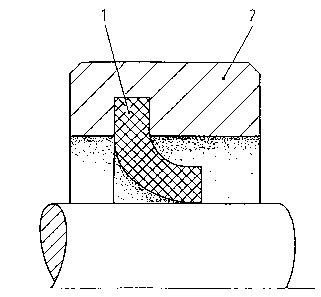Une partie des informations de ce site Web a été fournie par des sources externes. Le gouvernement du Canada n'assume aucune responsabilité concernant la précision, l'actualité ou la fiabilité des informations fournies par les sources externes. Les utilisateurs qui désirent employer cette information devraient consulter directement la source des informations. Le contenu fourni par les sources externes n'est pas assujetti aux exigences sur les langues officielles, la protection des renseignements personnels et l'accessibilité.
L'apparition de différences dans le texte et l'image des Revendications et de l'Abrégé dépend du moment auquel le document est publié. Les textes des Revendications et de l'Abrégé sont affichés :
| (12) Brevet: | (11) CA 1334764 |
|---|---|
| (21) Numéro de la demande: | 1334764 |
| (54) Titre français: | JOINT RADIAL |
| (54) Titre anglais: | RADIAL SEAL |
| Statut: | Périmé et au-delà du délai pour l’annulation |
| (51) Classification internationale des brevets (CIB): |
|
|---|---|
| (72) Inventeurs : |
|
| (73) Titulaires : |
|
| (71) Demandeurs : |
|
| (74) Agent: | BORDEN LADNER GERVAIS LLP |
| (74) Co-agent: | |
| (45) Délivré: | 1995-03-14 |
| (22) Date de dépôt: | 1986-01-14 |
| Licence disponible: | S.O. |
| Cédé au domaine public: | S.O. |
| (25) Langue des documents déposés: | Anglais |
| Traité de coopération en matière de brevets (PCT): | Non |
|---|
| (30) Données de priorité de la demande: | ||||||
|---|---|---|---|---|---|---|
|
A radial seal for a shaft, this being made up of a sealing element that is
produced from a flat disc with a surface that is parallel in plan, said disc
being of a non-elastomer plastic, preferably PTFE, this disc being inserted in
the area of its periphery into a reinforcing ring and being curved in the area
of its inner periphery to form a cylindrical end section, this being done by
cold forming, the seal so formed then lying against the shaft under tension,
characterized in that at a thickness of 0.8 - 2.0 mm the disc has an inside
diameter that is reduced by a factor of 1 - 6x the value of its thickness, the
distance of the reinforcing ring from the shaft at the point of installation
of the disc being 1.1 - 1.4x greater than the thickness of the disc.
Note : Les revendications sont présentées dans la langue officielle dans laquelle elles ont été soumises.
Note : Les descriptions sont présentées dans la langue officielle dans laquelle elles ont été soumises.

2024-08-01 : Dans le cadre de la transition vers les Brevets de nouvelle génération (BNG), la base de données sur les brevets canadiens (BDBC) contient désormais un Historique d'événement plus détaillé, qui reproduit le Journal des événements de notre nouvelle solution interne.
Veuillez noter que les événements débutant par « Inactive : » se réfèrent à des événements qui ne sont plus utilisés dans notre nouvelle solution interne.
Pour une meilleure compréhension de l'état de la demande ou brevet qui figure sur cette page, la rubrique Mise en garde , et les descriptions de Brevet , Historique d'événement , Taxes périodiques et Historique des paiements devraient être consultées.
| Description | Date |
|---|---|
| Inactive : CIB expirée | 2016-01-01 |
| Le délai pour l'annulation est expiré | 2006-03-14 |
| Lettre envoyée | 2005-03-14 |
| Lettre envoyée | 2002-11-04 |
| Accordé par délivrance | 1995-03-14 |
Il n'y a pas d'historique d'abandonnement
| Type de taxes | Anniversaire | Échéance | Date payée |
|---|---|---|---|
| TM (catégorie 1, 3e anniv.) - générale | 1998-03-16 | 1998-02-16 | |
| TM (catégorie 1, 4e anniv.) - générale | 1999-03-15 | 1999-02-10 | |
| TM (catégorie 1, 5e anniv.) - générale | 2000-03-14 | 1999-12-02 | |
| TM (catégorie 1, 6e anniv.) - générale | 2001-03-14 | 2001-02-15 | |
| TM (catégorie 1, 7e anniv.) - générale | 2002-03-14 | 2002-01-31 | |
| Enregistrement d'un document | 2002-08-28 | ||
| TM (catégorie 1, 8e anniv.) - générale | 2003-03-14 | 2003-02-18 | |
| TM (catégorie 1, 9e anniv.) - générale | 2004-03-15 | 2004-02-23 |
Les titulaires actuels et antérieures au dossier sont affichés en ordre alphabétique.
| Titulaires actuels au dossier |
|---|
| CARL FREUDENBERG KG |
| Titulaires antérieures au dossier |
|---|
| DIETER FUCHS |
| WOLFGANG SCHMITT |